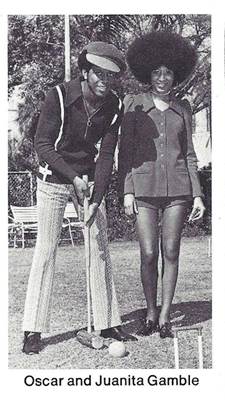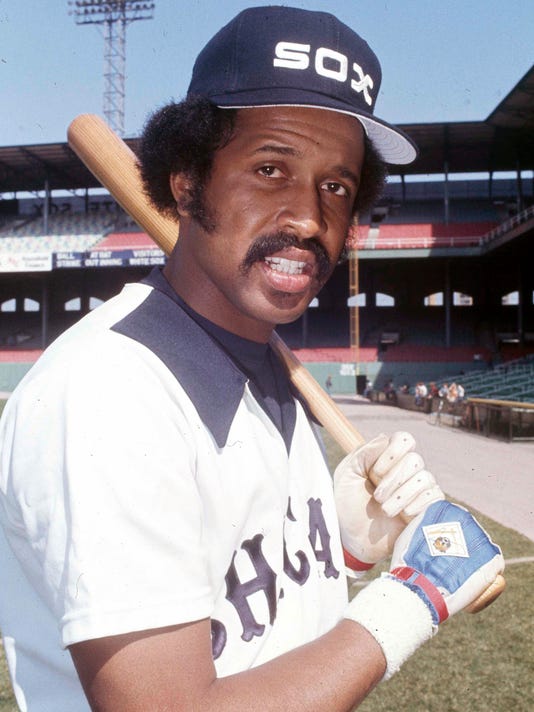Oscar Gamble was both.
Oscar Charles Gamble was born on December 20, 1949 in Ramer, Alabama, near the State Capital of Montgomery. The outfielder was discovered playing semi-pro ball in Montgomery by Negro Leagues legend Buck O'Neil, by then a scout for the Chicago Cubs. The Cubs drafted him in 1968.
He made his major league debut on August 27, 1969, only 19 years old. Batting 8th, playing center field, and wearing Number 20, he drew a walk off Tony Cloninger in the 2nd inning, popped to 3rd base in the 5th, singled to right in the 7th, and grounded to 2nd in the 9th. Despite a home run by Ron Santo and a hit each by Ernie Banks and Billy Williams, the Cubs lost to the Cincinnati Reds, 6-3 at Wrigley Field.
It was 1969. Baseball was behind the times.
No mustache yet. No Afro, either.
Even sideburns were still rare for ballplayers.
After the 1969 season, he was part of a trade package to the Philadelphia Phillies, with former All-Star Johnny Callison going the other way. It was with the Phillies that he began wearing Number 23. It was also in the Phunky city of Philadelphia that he began to look like a Seventies player.
Mustache: Check. Sideburns: Check.
Afro: Workin' on it. Powder-blue road uniform: Check.
Welcome to the 1970s.
On October 1, 1970, he singled Tim McCarver home in the bottom of the 10th inning, giving the Phils a 2-1 win over the Montreal Expos in the last game played in the 62-season history of Connie Mack Stadium (formerly Shibe Park), as the fans ran onto the field before McCarver even crossed the plate, and they tore the old ballpark apart. He did not, however, play in the Veterans Stadium opener on April 10, 1971.
Oscar and his wife, Juanita, in 1972.
Clearly, she was his inspiration.
After the 1972 season, the Phillies traded him to the Cleveland Indians. It was there that Oscar developed what became baseball's most memorable Afro, a hairstyle more frequently seen in the NBA and especially the ABA. It got to the point where he could barely get a cap or a batting helmet on over it.
No, I wasn't kidding.
The Indians didn't care, because he could play all 3 outfield positions, and he'd found his power stroke. In 3 seasons playing his home games in Cleveland Municipal Stadium, often known as "Cavernous Cleveland Stadium," where the foul poles were only 320 feet away but straightaway left and right were 380 feet, he hit 20 home runs in 1973, 19 in 1974, and 15 in 1975.
Right on.
The Yankees knew they were going back into the original Yankee Stadium after a 2-year renovation that forced them to groundshare with the Mets at Shea Stadium, so they took a chance that Gamble's lefthanded swing would be perfect for the "short porch" in right field, soon revealed to be 310 feet to the pole and 353 to the right-center power alley. On November 22, 1975 -- just 11 days after getting Mickey Rivers and Ed Figueroa from the California Angels and Willie Randolph from the Pittsburgh Pirates, they sent starting pitcher Pat Dobson to the Indians for Gamble.
The famous 1976 Topps "Traded" card.
Note the bad airbrushing on the cap and the jersey.
When Oscar reported to Spring Training in Fort Lauderdale in March 1976, he faced a dilemma. Team owner George Steinbrenner had a rule against long hair. He told Oscar he wasn't opposed to an Afro, as long as it was short and neat.
So he sent Oscar to the barber the team used down there. He was an old white man, who admitted that he'd never cut a black man's hair before. But it had been more than a decade after the Civil Rights Act, so he couldn't well refuse, especially since the Yankees likely would have taken all their business away from him if he had. He got Oscar down to where he met George's standards.
Result.
He only batted .232 for the Yankees in 1976, but he did hit 17 home runs with 57 RBIs. He became quite popular in New York, for his power, for his batting stance (an extreme crouch that Rivers also used, with better effect for average than for power), and for his personality. Broadcasting, Phil Rizzuto called him "The Big O," a nickname that had already been given to basketball star Oscar Robertson and singers Roy Orbison and Otis Redding. He had an RBI in the American League Championship Series, helping the Yankees win the Pennant. But he went just 1-for-8 in the Reds' 4-game sweep of the Yankees in the World Series.
The signing of Reggie Jackson in the off-season made Oscar expendable. And they needed a shortstop, badly. On April 5, 1977, the Yankees sent him to the Chicago White Sox with LaMarr Hoyt (who ended up winning the 1983 AL Cy Young Award) and Robert Polinsky (who never made the major leagues), for Bucky Dent, made expendable at Comiskey Park by the emergence of Alan Bannister.
1977 was, for a while, a great season for Chicago baseball. Both teams were in 1st place at the All-Star Break, the only time that's ever happened. But the Cubs then tailed off, and finished 81-81. The White Sox hung on longer, with horrible uniforms and an attack that got them nicknamed the South Side Hit Men.
Team owner Bill Veeck, well, took a gamble: He knew he wouldn't be able to afford to keep all those guys as free agency took hold in baseball, so he essentially traded for "rent-a-players" who could win it for him that year.
Oscar, now wearing Number 17, led the team with 31 home runs, and also had 83 RBIs. His OPS+ was 162, meaning he was 62 percent better at producing runs than the average player. Richie Zisk hit 30 homers and led the team with 101 RBIs. Eric Soderholm hit 25 homers, Chet Lemon 19, Jim Spencer and Lamar Johnson 18 each. Jorge Orta only had 11, but had 84 RBIs. Ralph Garr, who had won the National League batting title with the Atlanta Braves, only hit 10 homers, but batted .300. And Comiskey was a pitcher's park.
"Well, the South Side of Chicago is the baddest part of town."
-- Jim Croce
But the White Sox couldn't hold their lead in the AL Western Division, either. They slumped, and in early August, they got swept and overtaken by the Kansas City Royals. The problem was that they didn't have the pitching: They had 4 guys make at least 25 starts, and none of them had an ERA below 4.10. They had 6 making at least 13 starts, and 3 of those had an ERA above 4.80. They went 90-72, but only finished 3rd behind the Royals and Angels.
Veeck couldn't sign most of them to new contracts. Rising star Brian Downing was traded to the Angels. Zisk signed with the Texas Rangers, Spencer with the Yankees, Gamble with the San Diego Padres. Of the guys I mentioned, only Lemon was still there when Veeck sold the team in 1980.
To look at the 1978 Padres -- not easy, given their awful uniforms -- it seems like they were destined for a big season: Future Hall-of-Famers Gaylord Perry, Rollie Fingers, Dave Winfield and Ozzie Smith. All-Stars Mickey Lolich, Gene Tenace, Randy Jones, Gene Richards and Oscar Gamble.
The problem was, most of them were washed-up (like Lolich and Tenace), not yet developed (like Smith), or had a down year (like Jones and Gamble). They only went 84-78, well behind the NL West-leading Los Angeles Dodgers.
The Padres chose to trade Oscar to the Rangers after the season. He recovered his stroke, and on July 30, 1979, they traded him, pitchers Ray Fontenot and Gene Nelson (neither ever amounted to anything), and Amos Lewis (who never reached the majors) to the Yankees for Rivers for 4 players who never made the majors -- including, interestingly enough, the now-flopped Polinsky.
In mainly a pinch-hitting role, Oscar hit a career-high .358 in 1979, with 19 homers and 64 RBIs in just 274 at-bats. He continued to show some pop, and helped the Yankees win the AL East in 1980 and another Pennant in 1981.
In the decisive Game 5 of the strike-forced 1981 AL Eastern Division Series with the Milwaukee Brewers at Yankee Stadium, Reggie and Oscar hit tremendous back-to-back home runs, and the Yankees went on to sweep the Oakland Athletics in the ALCS. But the subsequent 6-game loss to the Dodgers, in which he went 2-for-6 with an RBI in 3 games, was the closest that Oscar would ever come to a World Series win.
After that, the Dynasty fell apart. Steinbrenner continued his managerial musical chairs. The organization was a mess, and was no longer winning enough to overlook it. Oscar was quoted as saying, "They don't think it be like it is, but it do."
It's not clear whether he said this in his 1st or 2nd run with the Yankees, but it may have inspired another New York athlete, Micheal Ray Richardson, to say of the Knicks, "The ship be sinking." When asked, "How low can it sink?" he answered, "The sky's the limit."
Having a glut of outfielders, the Yankees let his contract run out after the 1983 season, re-signed him early in the 1984 season, and then let him go again. He returned to the White Sox for 70 games in 1985, and that was it. He finished his career with a .265 batting average, a 127 OPS+, and an even 200 home runs.
*
Oscar returned to Montgomery, where he became a player agent, and ran a dance club, Oscar Gamble's Players Club. He was always invited back to Old-Timers' Day at Yankee Stadium, and usually came. He also served as an instructor at Steinbrenner Field in Tampa, both for Spring Training and Yankee fantasy camps. Some people noted with sadness that his famous hair was gone.
Sic transit gloria mundi.
He was married to the similarly once-spectacularly-coiffed Juanita, and they had 2 sons, one who played in the Phillies' organization, and one who played in college.
Oscar Gamble developed cancer of the jaw, and died today, January 31, 2018. He was 68 years old.
"Everybody remembers the hair," Reggie Jackson said today, "but what you need to know was that he was a sweet, decent man, without a single ounce of malice in his heart, one who came through the door every day with a smile on his face."
"One of the best teammates probably any of us ever had," said Goose Gossage. "As good a teammate as they come."
Hall of Fame players giving Hall of Fame praise to Oscar Gamble, a Hall of Fame person.
UPDATE: His final resting place is not publicly known.











No comments:
Post a Comment